Chapter: 11th Physics : UNIT 6 : Gravitation
Escape Speed and Orbital Speed
ESCAPE
SPEED AND ORBITAL SPEED
Hydrogen
and helium are the most abundant elements in the universe but EarthŌĆÖs
atmosphere consists mainly of nitrogen and oxygen. The following discussion
brings forth the reason why hydrogen and helium are not found in abundance on
the EarthŌĆÖs atmosphere. When an object is thrown up with some initial speed it
will reach a certain height after which it will fall back to Earth. If the same
object is thrown again with a higher speed, it reaches a greater height than
the previous one and falls back to Earth. This leads to the question of what
should be the speed of an object thrown vertically up such that it escapes the
EarthŌĆÖs gravity and would never come back.
Consider
an object of mass M on the surface of the Earth. When it is thrown up with an
initial speed vi , the
initial total energy of the object is

where,
ME is the mass of the
Earth and RE- the radius
of the Earth. The term ŌłÆ GMME / RE is the potential
energy of the mass M.
When
the object reaches a height far away from Earth and hence treated as
approaching infinity, the gravitational potential energy becomes zero [U( Ōł× ) 0] and the kinetic energy becomes
zero as well. Therefore the final total energy of the object becomes zero. This
is for minimum energy and for minimum speed to escape. Otherwise Kinetic energy
can be nonzero.

Consider
the escape speed, the minimum speed required by an object to escape EarthŌĆÖs
gravitational field, hence replace vi
with ve . i.e,
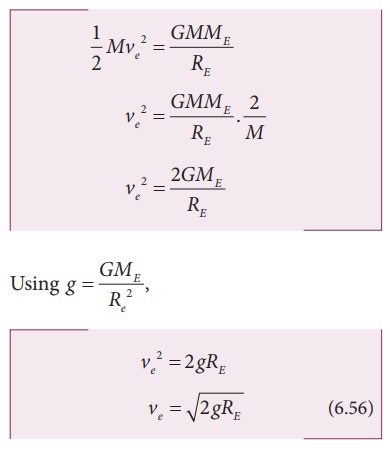
From
equation (6.56) the escape speed depends on two factors: acceleration due to
gravity and radius of the Earth. It is completely independent of the mass of
the object. By substituting the values of g (9.8 mŌĆåsŌłÆ2) and Re
= 6400 km, the escape speed of the Earth is v e = 11. 2 km s-1 . The escape speed is independent
of the direction in which the object is thrown. Irrespective of whether the
object is thrown vertically up, radially outwards or tangentially it requires
the same initial speed to escape EarthŌĆÖs gravity. It is shown in Figure 6.19.
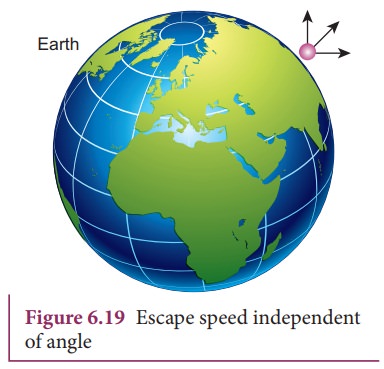
Lighter
molecules such as hydrogen and helium have enough speed to escape from the
Earth, unlike the heavier ones such as nitrogen and oxygen. (The average speed
of hydrogen and helium atoms compaired with the escape speed of the Earth,is
presented in the kinetic theory of gases).
Satellites,
orbital speed and time period
We
are living in a modern world with sophisticated technological gadgets and are
able to communicate to any place on Earth. This advancement was made possible
because of our understanding of solar system. Communication mainly depends on
the satellites that orbit the Earth (Figure 6.20). Satellites revolve around
the Earth just like the planets revolve around the Sun. KeplerŌĆÖs laws are
applicable to man-made satellites also.
For
a satellite of mass M to move in a
circular orbit, centripetal force must be acting on the satellite. This
centripetal force is provided by the EarthŌĆÖs gravitational force.
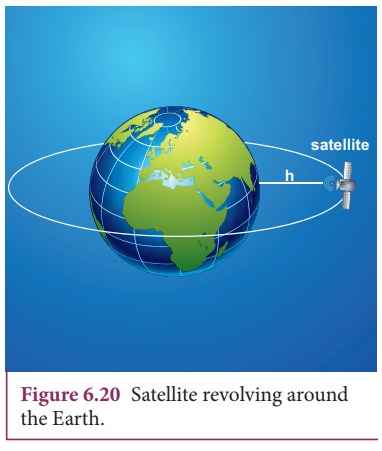
As
h increases, the speed of the satellite decreases.
Time period of the satellite:
The
distance covered by the satellite during one rotation in its orbit is equal to
2ŽĆ(RE +h and time taken for it is the time
period, T. Then
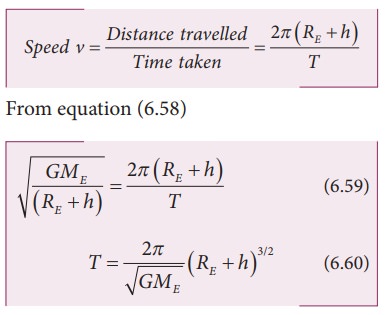
Squaring
both sides of the equation (6.60), we get
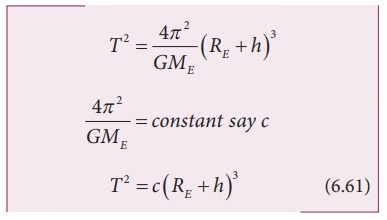
Equation
(6.61) implies that a satellite orbiting the Earth has the same relation
between time and distance as that of KeplerŌĆÖs law of planetary motion. For a
satellite orbiting near the surface of the Earth, h is negligible compared to
the radius of the Earth RE.
Then,
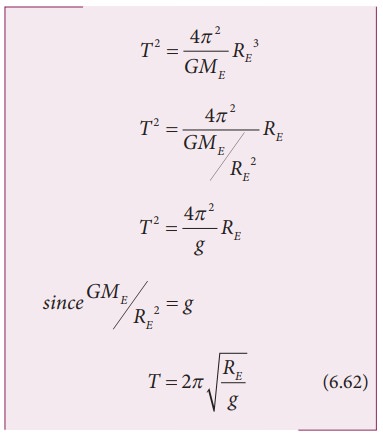
By
substituting the values of RE
= 6.4 ├Ś 106m and g = 9.8 mŌĆåsŌłÆ2, the orbital time period is obtained
as T Ōēģ 85 minutes.
EXAMPLE 6.9
Moon
is the natural satellite of Earth and it takes 27 days to go once around its
orbit. Calculate the distance of the Moon from the surface of the Earth
assuming the orbit of the Moon as circular.
Solution
We
can use KeplerŌĆÖs third law,
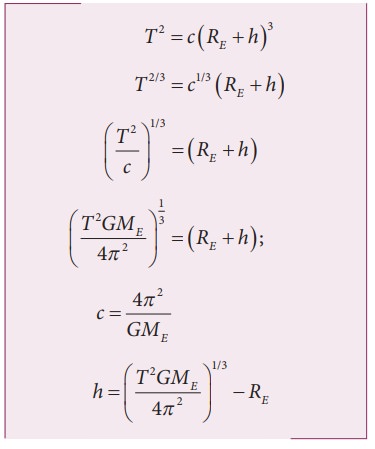
Here
h is the distance of the Moon from
the surface of the Earth. Here,
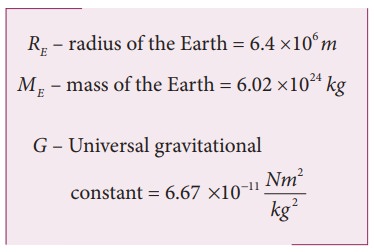
By substituting these values, the distance to the Moon from the surface of the Earth is calculated to be 3.77 ├Ś105 km.
Energy of an Orbiting Satellite
The
total energy of a satellite orbiting the Earth at a distance h from the surface
of Earth is calculated as follows; The total energy of the satellite is the sum
of its kinetic energy and the gravitational potential energy. The potential
energy of the satellite is,

Here
Ms - mass of the
satellite, ME - mass of
the Earth, RE - radius of
the Earth. The Kinetic energy of the satellite is

Here
v is the orbital speed of the
satellite and is equal to

Substituting
the value of v in (6.64), the kinetic energy of the satellite becomes,
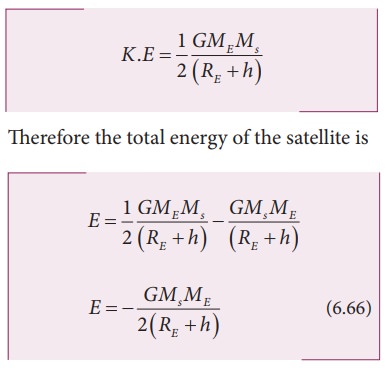
The
negative sign in the total energy implies that the satellite is bound to the
Earth and it cannot escape from the Earth.
As
h approaches Ōł×, the total energy
tends to zero. Its physical meaning is that the satellite is completely free
from the influence of EarthŌĆÖs gravity and is not bound to Earth at large
distances.
EXAMPLE 6.10
Calculate
the energy of the (i) Moon orbiting the Earth and (ii) Earth orbiting the Sun.
Solution
Assuming
the orbit of the Moon to be circular, the energy of Moon is given by,

where ME is the mass of Earth 6.02 ├Ś1024 kg; Mm is the mass of Moon 7.35
├Ś1022 kg; and R is the
distance between the Moon and the center of the Earth 3.84 ├Ś105 km
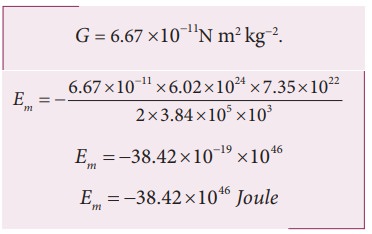
The
negative energy implies that the Moon is bound to the Earth.
Same method can be used to prove that the energy of the Earth is also negative.
Geo-stationary and polar satellite
The
satellites orbiting the Earth have different time periods corresponding to
different orbital radii. Can we calculate the orbital radius of a satellite if
its time period is 24 hours?
KeplerŌĆÖs
third law is used to find the radius of the orbit.
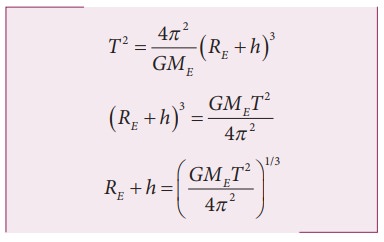
Substituting
for the time period (24 hrs = 86400 seconds), mass, and radius of the Earth, h
turns out to be 36,000 km. Such satellites are called ŌĆ£geo-stationary
satellitesŌĆØ, since they appear to be stationary when seen from Earth.
India
uses the INSAT group of satellites that are basically geo-stationary satellites
for the purpose of telecommunication. Another type of satellite which is placed
at a distance
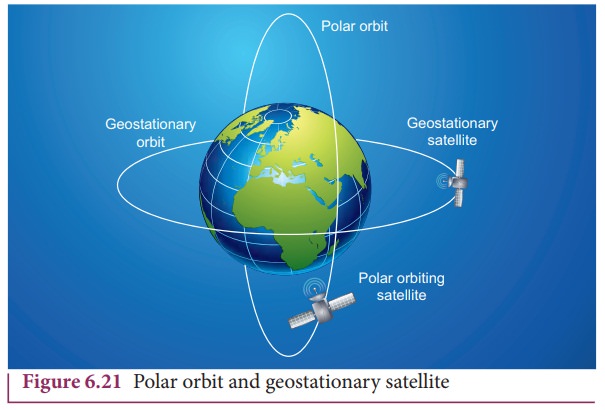
This type of satellite that orbits Earth from North Pole to
South Pole is called a polar satellite. The time period of a polar satellite is
nearly 100 minutes and the satellite completes many revolutions in a day. A
Polar satellite covers a small strip of area from pole to pole during one
revolution. In the next revolution it covers a different strip of area since
the Earth would have moved by a small angle. In this way polar satellites cover
the entire surface area of the Earth.
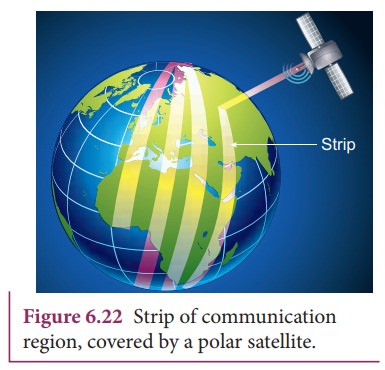
Weightlessness Weight of an object
Objects
on Earth experience the gravitational force of Earth. The gravitational force
acting on an object of mass m is mg. This force always acts downwards towards
the center of the Earth. When we stand on the floor, there are two forces
acting on us. One is the gravitational force, acting downwards and the other is
the normal force exerted by the floor upwards on us to keep us at rest. The
weight of an object ![]() is
defined as the downward force whose magnitude W is equal to that of upward
force that must be applied to the object to hold it at rest or at constant
velocity relative to the earth. The direction of weight is in the direction of
gravitational force. So the magnitude of weight of an object is denoted as,
W=N=mg. Note that even though magnitude of weight is equal to mg, it is not
same as gravitational force acting on the object.
is
defined as the downward force whose magnitude W is equal to that of upward
force that must be applied to the object to hold it at rest or at constant
velocity relative to the earth. The direction of weight is in the direction of
gravitational force. So the magnitude of weight of an object is denoted as,
W=N=mg. Note that even though magnitude of weight is equal to mg, it is not
same as gravitational force acting on the object.
Apparent weight in elevators
Everyone
who used an elevator would have felt a jerk when the elevator takes off or
stops. Why does it happen? Understanding the concept of weight is crucial for
explaining this effect. Let us consider a man inside an elevator in the
following scenarios.
When
a man is standing in the elevator, there are two forces acting on him.
1.
Gravitational force which acts downward. If we take the vertical direction as
positive y direction, the gravitational force acting on the man is 
2.
The normal force exerted by floor on the man which acts vertically upward, 
Case (i) When the elevator is at rest
The
acceleration of the man is zero. Therefore the net force acting on the man is
zero. With respect to inertial frame (ground), applying NewtonŌĆÖs second law on
the man,
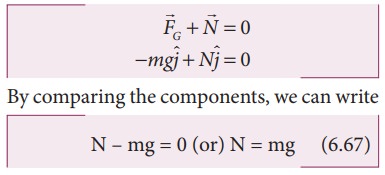
Since
weight, W =N, the apparent weight of the man is equal to his actual weight.
Case (ii) When the elevator is moving uniformly in the upward or downward direction
In
uniform motion (constant velocity), the net force acting on the man is still
zero.
Hence,
in this case also the apparent weight of the man is equal to his actual weight.
It is shown in Figure 6.23(a)
![]()
![]()
Case (iii) When the elevator is accelerating upwards
If
an elevator is moving with upward acceleration  with respect to inertial frame (ground), applying NewtonŌĆÖs second law on the
man,
with respect to inertial frame (ground), applying NewtonŌĆÖs second law on the
man,

Writing
the above equation in terms of unit vector in the vertical direction,

Therefore,
apparent weight of the man is greater than his actual weight. It is shown in
Figure 6.23(b)
Case (iv) When the elevator is accelerating downwards
If
the elevator is moving with downward acceleration  , by
applying NewtonŌĆÖs second law on the man, we can write
, by
applying NewtonŌĆÖs second law on the man, we can write

Writing
the above equation in terms of unit vector in the vertical direction,
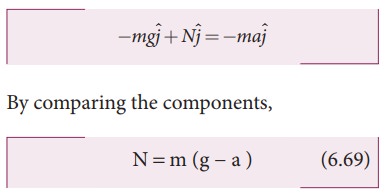
Therefore,
apparent weight W = N = m(g-a) of the man is lesser than
his actual weight. It is shown in Figure 6.23(c)
Weightlessness of freely falling bodies
Freely
falling objects experience only gravitational force. As they fall freely, they
are not in contact with any surface (by neglecting air friction). The normal
force acting on the object is zero. The downward acceleration is equal to the
acceleration due to the gravity of the Earth. i.e (a = g). From equation (6.69) we get.

This
is called the state of weightlessness. When the lift falls (when the lift wire
cuts) with downward acceleration aŌĆå=ŌĆåg, the
person inside the elevator is in the state of weightlessness or free fall. It
is shown in Figure 6.23(d)
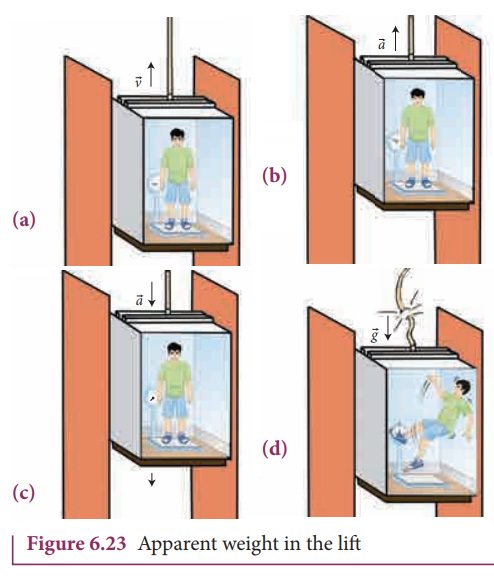
When the apple was falling from the
tree it was weightless.As soon as it hit NewtonŌĆÖs head, it gained weight! and
Newton gained physics!
Weightlessness in satellites:
There
is a wrong notion that the astronauts in satellites experience no gravitational
force because they are far away from the Earth. Actually the Earth satellites
that orbit very close to Earth experience only gravitational force. The
astronauts inside the satellite also experience the same gravitational force.
Because of this, they cannot exert any force on the floor of the satellite.
Thus, the floor of the satellite also cannot exert any normal force on the
astronaut. Therefore, the astronauts inside a satellite are in the state of weightlessness.
Not only the astronauts, but all the objects in the satellite will be in the
state of weightlessness which is similar to that of a free fall. It is shown in
the Figure 6.24.
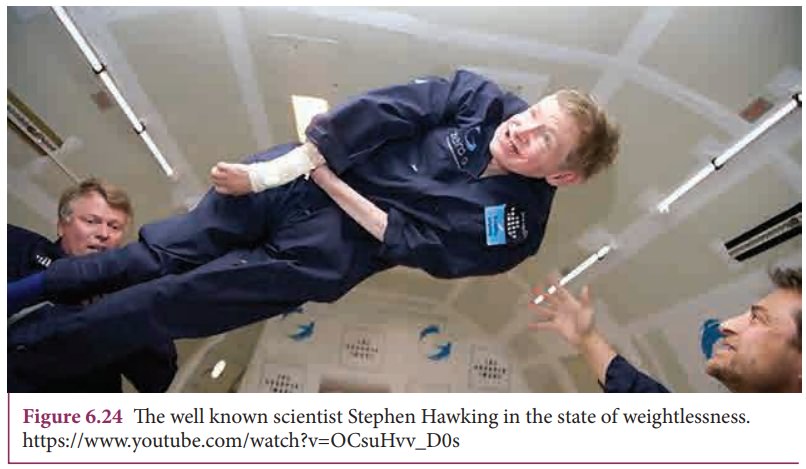
Related Topics